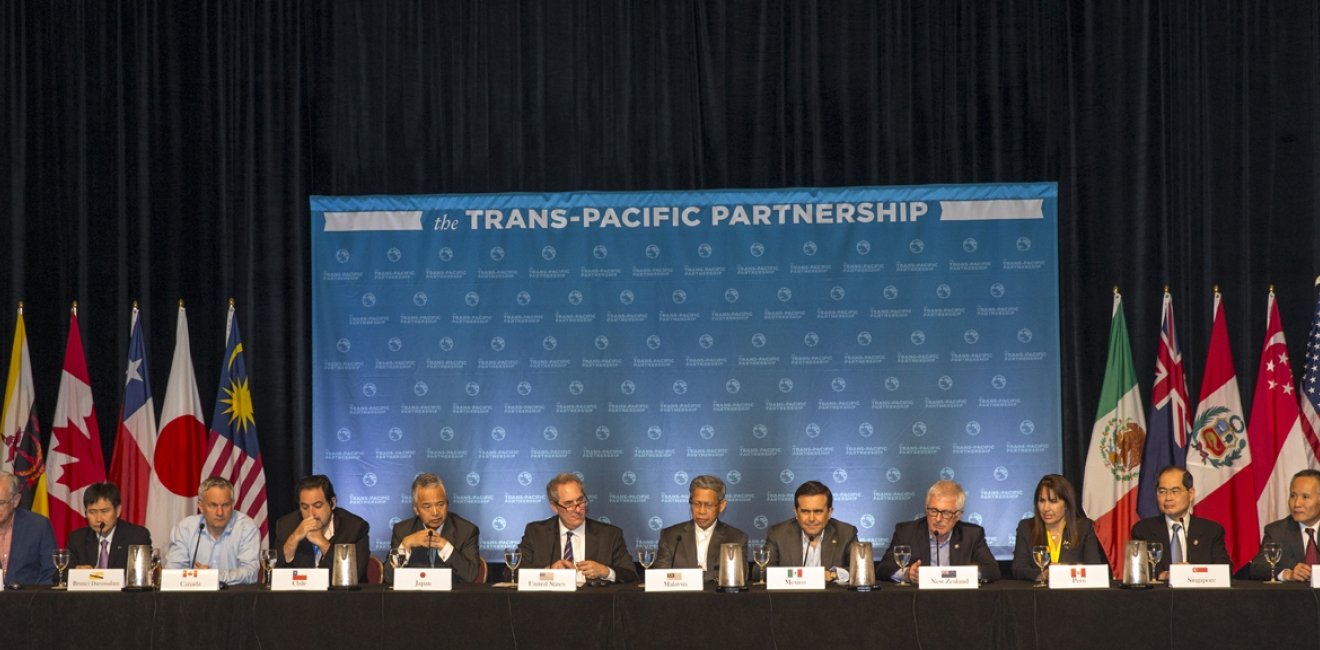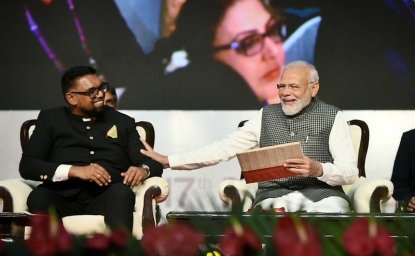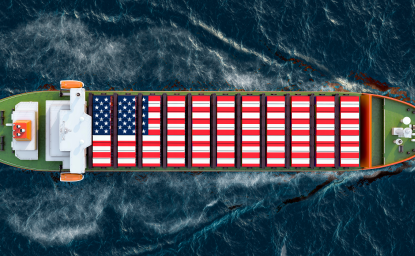Could the TPP Actually Divide Asia?
"There is reason to worry that the trade deal may actually lead to increased tensions in the region, and not just between Washington and Beijing," writes Shihoko Goto.
"There is reason to worry that the trade deal may actually lead to increased tensions in the region, and not just between Washington and Beijing," writes Shihoko Goto.

Trade deals always produce losers as well as winners, so it is no surprise that there is growing concern that the Trans-Pacific Partnership (TPP) agreement will not be ratified by all 12 member countries. But if it does come into force, the seemingly unshakeable assumption is that the TPP will be the foundation for continued U.S. engagement in Asia, and that it will ensure stability in a region increasingly riven by nationalism, territorial disputes, and militarism.
For now, U.S. legislators are rightly focused on the harm as well as the benefits TPP could bring. Among those expressing skepticism about the economic benefits of the TPP are Senator Orrin Hatch, chairman of the powerful Senate Finance Committee, and it is not certain that Congress will even pass the TPP, even with Trade Promotion Authority in place. Certainly, as the U.S. presidential elections gear up, the benefits and demerits of a mega-trade deal will become a hot-button issue.
But even as the pros and cons in each sector are weighed, the White House will undoubtedly remain resolute about the security implications of the TPP. Touted as the economic component of a broader U.S. rebalance to Asia, the TPP has been pushed by the Obama administration as key to ensuring strategic U.S. ties to Asia, a framework that will ensure sustainable U.S. engagement in the world’s most populous and economically vibrant region.
However, there is reason to worry that the trade deal may actually lead to increased tensions in the region, and not just between Washington and Beijing. This in turn would complicate rather than strengthen U.S. strategy in the region.
As Important as ‘Another Aircraft Carrier’
To be sure, the fact that the United States has played a leading role in a deal that represents 40 percent of global GDP while China has not was a huge selling point when the White House tried to push through TPA earlier this year. And the administration has not shied away from mobilizing its senior security officials, including Secretary of Defense Ashton Carter, who stated that “passing TPP is as important to me as another aircraft carrier.”
All trade deals, of course, reflect security as well as economic interests between governments, and the TPP is no exception. But stressing the security angle of the trade deal comes in part from the fact that China is not one of the founding members of the deal. Moreover, even as Washington emphasizes the so-called open architecture of TPP, which could allow more nations to join down the line, China among them, it is very evident that the White House views the deal as a way to have the United States play the lead role in setting future trade rules before China does.
The Obama administration believes the TPP would bolster U.S. strategic ties to key Asian allies, including Japan, Australia, New Zealand, and Singapore, while enhancing relations with nations that could counterbalance China’s growing influence in the region by bringing Vietnam and Malaysia into the TPP fold. The belief has been that relations between the 12 TPP member nations would become closer not just economically, but on the security front as well. And it is true, closer economic ties have often led to enhanced military cooperation, as can be seen in the case of Japan and Australia following the signing of their bilateral free trade agreement in April 2014, which came into effect earlier this year. Since then, the two countries have also expanded their military ties, which in turn has enhanced relations for both countries with the United States. Yet the assumption of a positive spillover effect of TPP membership under an umbrella of a common trade agenda may not always hold true.
The Obama administration believes the TPP would bolster U.S. strategic ties to key Asian allies, including Japan, Australia, New Zealand, and Singapore, while enhancing relations with nations that could counterbalance China’s growing influence in the region by bringing Vietnam and Malaysia into the TPP fold.
For instance, the prevailing view in Washington is that South Korea will be one of the first countries to join the TPP once it is ratified, given that a high standard U.S.-Korea free trade agreement (KORUS) came into effect in March 2012. South Korea is undoubtedly a strong candidate to join the group, given that KORUS is seen as a gold standard for free trade deals. Nevertheless, the U.S.-Korea free trade pact largely exempted the politically sensitive Korean rice market. That alone will undoubtedly be a major political issue for all member countries should Korea negotiate entry into the pact, and it will certainly be a source of contention with Japan, a founding member of the TPP that was forced to make concessions on its equally politically sensitive rice market. Any dispute about access to South Korea’s rice market made by Japanese negotiators would certainly hamper relations between Seoul and Tokyo, which are already frosty as the two sides continue to grapple over the politics of historical memory and rising nationalism. Washington may hope that the TPP could help ease the tensions. Instead, negotiations for Korean entry into the bloc could in fact put additional pressure on relations in northeast Asia, at least in the near term.
Another source of tension in the region will undoubtedly be Taiwan’s desire to join the TPP on the one hand, and the international community dealing with the “one China” policy on the other. The Taiwanese government has made clear that it hopes to be one of the first entrants to the TPP, not only to further its position as a global exporter, but also to encourage domestic reform that is critical if Taiwan is to remain competitive. Given its experience in joining the World Trade Organization, whereby it had to wait until China was ready for accession in 2001 so that it could join at the same time, there is growing concern that Taipei would have to wait again for Beijing to be ready. The frustration of being unable to join a group that is seen as key to Taiwan’s growth will undoubtedly strain cross-Strait relations.
The TPP is not the only multilateral trade deal being discussed in Asia. Indeed, if greater regional stability and economic integration is the objective, then there are alternative frameworks. The Regional Comprehensive Economic Partnership (RCEP) includes not only all 10 ASEAN countries, but also China, Japan, South Korea, India, Australia, and New Zealand. Critics of the RCEP have been quick to dismiss the pact as aiming at lower standards compared to the TPP, and as focused too heavily on relatively unambitious tariff barrier reductions. Moreover, it is seen as a Chinese-led initiative that does not include the United States. Yet the fact that RCEP brings hitherto unlikely partners such as Burma and Cambodia into the fold of regional trade agreements in itself should be heralded as a significant development that has already achieved what is one of the major longer-term goals of TPP, namely to encourage nations to adopt internationally developed rules and standards. What’s more, the fact that both Japan and South Korea are founding members of RCEP, and are therefore on equal footing, could help thaw tense relations. It may also encourage Tokyo and Seoul to work together to move forward in the China-Japan-Korea trilateral free trade agreement, which has stalled in recent years.
Of course, it is still too early to assess when and whether TPP will be ratified by all 12 member countries. What is clear, though, is that RCEP should continue to move forward regardless of TPP’s future. It may actually prove to be a better agreement to bring rival Asian nations together to work on a common agenda of continued economic growth in the region, even without the United States.
The opinions expressed here are those solely of the author.
This article was originally published in The Diplomat.


The Indo-Pacific Program promotes policy debate and intellectual discussions on US interests in the Asia-Pacific as well as political, economic, security, and social issues relating to the world’s most populous and economically dynamic region. Read more


